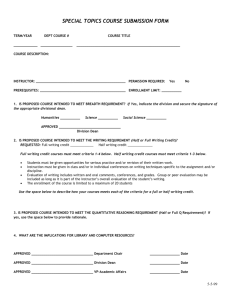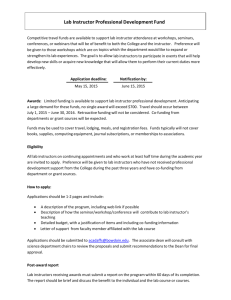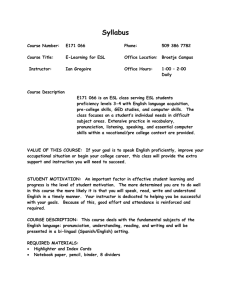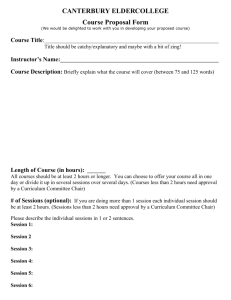OcSyllabus Generic for website
advertisement
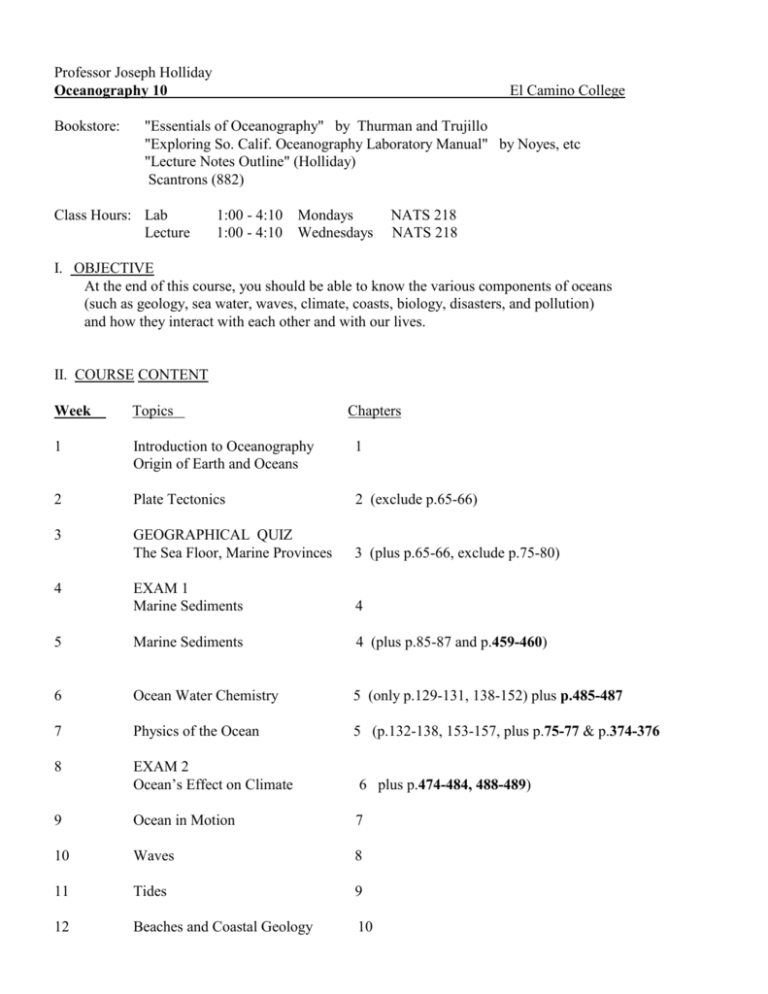
Professor Joseph Holliday Oceanography 10 Bookstore: El Camino College "Essentials of Oceanography" by Thurman and Trujillo "Exploring So. Calif. Oceanography Laboratory Manual" by Noyes, etc "Lecture Notes Outline" (Holliday) Scantrons (882) Class Hours: Lab Lecture 1:00 - 4:10 Mondays 1:00 - 4:10 Wednesdays NATS 218 NATS 218 I. OBJECTIVE At the end of this course, you should be able to know the various components of oceans (such as geology, sea water, waves, climate, coasts, biology, disasters, and pollution) and how they interact with each other and with our lives. II. COURSE CONTENT Week Topics 1 Introduction to Oceanography Origin of Earth and Oceans 1 2 Plate Tectonics 2 (exclude p.65-66) 3 GEOGRAPHICAL QUIZ The Sea Floor, Marine Provinces 3 (plus p.65-66, exclude p.75-80) EXAM 1 Marine Sediments 4 5 Marine Sediments 4 (plus p.85-87 and p.459-460) 6 Ocean Water Chemistry 5 (only p.129-131, 138-152) plus p.485-487 7 Physics of the Ocean 5 (p.132-138, 153-157, plus p.75-77 & p.374-376 8 EXAM 2 Ocean’s Effect on Climate 6 plus p.474-484, 488-489) 9 Ocean in Motion 7 10 Waves 8 11 Tides 9 12 Beaches and Coastal Geology 10 4 Chapters 13 14 EXAM 3 Estuaries and Pollution 11 RESEARCH OUTLINE DUE Life in the Ocean Productivity 15 RESEARCH PAPER DUE Marine Resources & Technology 16 Exam 4 & lab exam 2 (Dec. 16) 13 (only p.380-388) 4 (p.125-124), plus p.395-401) III. GRADING: Grades: Grades will be based on the following: Geographical Places Quiz Attendance/Participation Homework Research Outline First Exam 2nd, 3rd, & 4th Exams Lab Assignments, Tests, Field Trips & Attendance 3% 2% 10% 5% 12% 16% each 20% EXAMS: THE EXAMS NORMALLY CAN NOT BE MADE UP. The replacement tests for students who contact me before test time are all essay! If you cannot be at an exam, CALL ME at (310)-532-3670 ext 3371 (office) before the exam. All exams contain multiple choice and short essay questions. Cheating will result in class failure and name submitted to college authorities. Please bring a scantron (882-ES) to each exam. . QUIZ: The quiz is during week 3 and is on geographical places names that are on the list (list and maps on p. 2-4 in notes). RESEARCH OUTLINES and PAPER: These are to be typed, one-page outline summaries of scientific journal articles dealing with oceanography. Detailed directions will be handed out later. They are mandatory and are DUE week 14 and 15 respectively LAB ASSIGNMENTS AND TESTS: The laboratory assignments are mandatory and are to be done within the lab period. More than one absence must be made up. The class will take four field trips during lab periods. We will visit the beach, tide pools, and a pier, with the dates for the trips to be announced. There will be at least two lab tests (bring scantrons to them) and a separate lab syllabus. HOMEWORK: There will be homework assigned every week, consisting of questions to be answered from the textbook or some other assignment. They are to be turned in at the beginning of the lecture period they are due. Homework will be graded down for lateness. 10% of the homework grade will be a news article (newspaper, magazine, internet) of oceanography-related news, plus a three-sentence analysis, turned in every week. IV. INSTRUCTOR-STUDENT_MEETINGS: Feel free to confer with me about your grades and study habits, particularly if you are earning less than a "C" following the first exam. I expect anyone not passing a class to meet with me about using study cards or groups. I am available after class, as well as during office hours, which are most often held in our classroom. My office is room NATS 212-C. My office phone number is (310)-532-3670 ext 3371. . My office hours (either in office or classrooms) are: Monday 12:30 – 1:00, 4:15 – 4:45 Tuesday 10:30 – 11:00 Wednesday 12:30 - 1:00, 5:30 – 6:00 Thursday 10:30 – 11:00 You can also contact me by email at JoeWHolliday@yahoo.com V. ATTENDANCE and PARTICIPATION: College students are responsible for class attendance. Attendance accounting will be taken at each class meeting, and excessive (more than one lecture or more than one lab) unexcused absences will have a negative affect on the student's grade. More than one missed lab must be made up. Lecture notes are the best indication of what subject matter from the text will be on the exams. Each student is responsible for the content of all lectures, assignments, and text readings. The textbook reading for each chapter is to be completed before the topic is covered in class. Our textbook is probably the best in the country, but much of the technical information in the textbook will left out of the lectures and will not be included in the exams. I think you will consider this book to be one of your favorite textbooks by the end of your college and will decide to keep it forever! VI. WITHDRAWALS: The last day to add the class or to withdraw without a W is week 2. The last day to withdraw (with a W) is usually week 13. After that date, withdrawals are not permitted, except for serious reasons such as health. To avoid failures, submit a petition for withdrawal to the Admissions and Records Office if you are dropping the course. Honors Transfer Program Course This oceanography course is a specifically designated section for the Honors Transfer Program (HTP). As a result, this class will have some additional assignments not always found in non-HTP sections of oceanography. There will be extra writing assignments, in keeping with the spirit of the HTP. In addition, there will be other assignments and classroom discussions not found in regular oceanography sections. The class is a mixture of HTP students and non-HTP students, but everyone will be assigned the same assignments and graded on the same scale because some students may count this class retroactively as one of their HTP classes. I look forward to a fun, yet educational, semester with you. We are going to prove that a science course can be fun, interesting, and full of practical information you will use the rest of your lives. Classroom Guidelines: 1. 2 3. 4. 5. 6. Student Learning Outcomes: 1. Students can identify the salient features of the basic concepts of oceanography. (This includes the ability to recall the definitions of the specialized vocabulary of oceanography.) 2. Students recognize and can accurately articulate how the ocean affects humans’ lives and how human activities affect the ocean. 3. Students can identify the key elements of the scientific method (hypotheses, tests, observations, conclusions/interpretation of observations) in popular accounts of scientific research in magazines, newspapers, etc. Course Objectives Students who pass this course will be able to: 1. Use the theory of plate tectonics to explain observed features of the Earth’s surface including continents and ocean basins, earthquakes, fossil remains, islands, mountains, oceanic ridges, trenches, and volcanoes. Also, they will be able to use observations of the Earth to assess the validity of the theory of plate tectonics. 2. Describe the chemical and physical properties of water and seawater, and explain these properties in terms of the behavior of atoms and molecules. Also, they will be able to explain how these properties affect the behavior and movement of seawater. 3. Describe and explain how the ocean and atmosphere interact with one another, especially how the ocean affects climate and the impact that global warming will have on the ocean. 4. Describe the surface and deep circulation of the ocean, and explain the observed motion of the ocean in terms of wind forcing, the Coriolis effect, and density differences. 5. Describe the formation of waves (wind-generated, internal, and tsunami), and explain how wave phenomena such as refraction, reflection, standing waves, and wave dispersion affect their propagation and characteristics (e.g., wavelength, height, period). Also, explain how and why waves change as they shoal, and how coastal variations can produce different breaking patterns. 6. Explain the observed daily and monthly cycles of the tides using the equilibrium and dynamic theories of the tides, and explain how local conditions (e.g., shoreline shape, weather) can affect tidal patterns. 7. Explain the origin of coastal features such as sandy and rocky beaches, headlands, coves, sea arches, sea stacks, wave-cut and marine terraces, barrier islands, spits, and tombolos in terms of wave conditions, tides, and changes in sea level. 8. Explain the origin, movement, modification, and deposition of marine sediments in terms of the physical, chemical, and biological conditions affecting them. 9. Describe and explain the spatial and temporal distribution of ocean primary productivity (algae growth) in terms of the availability of sunlight and nutrients. Describe the flow of energy and nutrients into, through, and out of marine food webs, and analyze how human actions can disrupt food webs. 10. Describe special adaptations of marine organisms, and explain how these adaptations promote their survival and reproduction under the unique physical and chemical conditions found in the ocean. 11. Interpret contour maps, and find locations, measure distances, and take into account scaling factors on nautical charts. (Map Skills) 12. Solve problems using dimensional analysis, and calculate percentages, areas, and volumes. (Math Calculation Skills) 13. Prepare and analyze graphs, including time-series graphs, histograms, multivariate graphs, scatter plots, and pie charts. (Math Graphing Skills) 14. Make and describe observations, propose hypotheses and experiments to test hypotheses, and present an argument supporting or undermining hypotheses in terms of the observations. ATTENDANCE Attendance at First Class Students who enroll in class but do not attend the first scheduled class meeting may be dropped from the roster and their places given to waiting students who were unable to enroll at the time of registration. Attendance Without Official Enrollment Students will not be permitted to attend classes in which they are not enrolled. Exceptions may be allowed by the instructor for bonafide visitors. Attendance During Semester Regular attendance is expected of every student. A student may be dropped from class when absences from class exceed the number of units assigned to the course. This rule also applies to excessive absences due to illness or medical treatment. The student who has been absent due to illness or medical appointment must explain the absence directly to the instructor. The student who has been absent due to a communicable disease or quarantine must report directly to the Health Center for clearance before returning to classes. Adding a Class If space is available‚ students who have completed registration may add a class by going to the first meeting of the class and securing permission of the instructor. Students must follow all college and procedures by the published deadline. Withdrawal from Class Official withdrawal from class may be be processed through the online system, telephone, or in the Admissions Office. Failure to complete this process may result in the assignment of a letter grade of A through F. Standards of Conduct General Policy Conduct at El Camino College must conform to the laws of the State of California, District policies, and campus rules and regulations. The El Camino College faculty, staff and administration are dedicated to maintaining an optimal learning environment; the standards of behavior as outlined in this policy are essential to the maintenance of a quality college environment. These standards will apply to all students on campus, other college property or while attending any college-sponsored event. Violation of such laws, policies, rules and regulations or behavior adversely affecting suitability as a student, will lead to disciplinary action. Disciplinary actions as noted in Section II may be taken against any person who engages in behavior defined as misconduct as listed. Misconduct Dishonesty, including but not limited to cheating, plagiarism or knowingly furnishing false information to the College. Forgery, alteration, or misuse of college documents, records, or identification. Continued disruptive behavior, continued willful disobedience, profanity or vulgarity, or continued defiance of the authority of, or abuse of, college personnel or to anyone on campus. Participation in hazing or commitment of any act that tends to injure, degrade or disgrace a student or college personnel. Obstruction or disruption of teaching, research, administration, disciplinary proceedings, or other authorized college activities including but not limited to its community service functions or to authorized activities held off campus. Obstruction or disruption includes but is not limited to the use of skateboards, bicycles, radios, and roller skates. Persistent, serious misconduct not listed above. Disciplinary Action Disciplinary action appropriate to the misconduct as defined above may be taken by an instructor (see below), the Dean of Student Services or his or her designee (see below), and the Board of Trustees (see below). Discipline The following types of disciplinary action may be taken or pursued by the college: Warning - A verbal or written notice, given to the student by a faculty member, the Dean of Student Services or any college manager that continuation or repetition of the specified conduct may be cause for other disciplinary action. Reprimand - A written reprimand for violation of specified regulations sent to the student by the Dean of Student Services, noting that continued violations may result in further disciplinary action. The Dean of Student Services shall place a copy of this reprimand in the student file. Removal by Instructor - In addition to an instructor’s right to drop a student permanently from a class when the student is no longer participating i.e. lack of attendance in the course, an instructor may remove (suspend) a student from his or her class for the day of the incident and the next class meeting. During this period of removal, a conference should be held with the instructor and the student to attempt to resolve the situation that led to the student’s removal and the student shall not be returned to the class from which he or she was removed without the concurrence of the instructor of the class. If a student is suspended for one class meeting, no additional formal disciplinary procedures are necessary. If a student is suspended from class for the day of the incident and the next class meeting, the instructor shall send a written report of the action to his or her dean who shall forward this information to the Dean of Student Services, the Vice President of Student Services, and the President. If the student removed by an instructor is a minor, the President’s designee (Dean of Student Services) shall ask a parent or guardian of the student to attend a parent conference regarding the removal as soon as possible. If the instructor or the parent or guardian so requests, a college administrator shall attend the conference. The instructor may recommend to his or her dean that a student be suspended for longer than two class meetings. If the dean, instructor and student cannot resolve the problem, the suspension will be referred to the President or the President’s designee (Dean of Student Services) for possible actions described in Section 6 of this item. Suspension- The President or the President’s designee (Dean of Student Services) may suspend a student as follows: a. From one or more classes for a period of up to ten days of instruction; or b. From one or more classes for the remainder of the term; or c. From one or more classes and activities of the community college for one or more terms. The Dean of Student Services shall send the notice of suspension to the student, the student file, the Vice President of Student Services, the President of the College and the Campus Police. Whenever a minor is suspended from the College, the parent or guardian shall be notified in writing by the President or the President’s designee (Dean of Student Services). ci. uring the period following the initial suspension from class for the day of the incident and the following class meeting, the student shall be allowed to return to the class until due process and the disciplinary procedures are completed unless the student is further suspended as a result of actions taken as defined in Section 6 of this item. Cheating or Plagiarism Cheating violates Section I.B.1 of El Camino College’s Board Policy 5138, Standards of Student Conduct. The El Camino College faculty, staff and administrators are dedicated to maintaining an optimal learning environment and will not tolerate academic dishonesty. To uphold the academic integrity of the institution, all members of the academic community, faculty and students alike, must assume responsibility for providing an educational environment of the highest standards characterized by a spirit of academic honesty. The following statement is part of Board Policy 5138, Standards of Conduct: “Dishonesty, including but not limited to cheating, plagiarism or knowingly furnishing false information to the college.’’ When there is evidence of cheating or plagiarism in classroom work, students may receive an F for that piece of work or may be suspended from all classes for that term and the following term if deemed appropriate. Examples of Cheating or Plagiarism are: § Representing the words, ideas or work of another as one’s own in any academic exercise (plagiarism), including the use of commercial term paper companies; Copying or allowing another student to copy from one’s paper or answer sheet during an examination; § § Allowing another individual to assume one’s identity for the purpose of enhancing one’s grade in any of the following: testing, field trips or attendance; § Falsifying or attempting to falsify attendance records and/or grade rosters; § Changing answers on a previously scored test, assignment or experiment with the intent to defraud; § Inventing data for the purpose of completing a laboratory experiment or case study analysis with the intent to defraud; § Giving and/or taking information during an examination by any means such as sign language, hand signals or secret codes; § Obtaining copies of notes, exams or exam questions by any means other than distribution from the instructor. (This includes copying and removing exam questions from the classroom for any purpose.); § Using study aids such as calculators, tape recorders or notes that have been specifically prohibited by the instructor. Responsibility of El Camino College Students It is the responsibility of each student to conduct him/herself in a manner which encourages learning and promotes honesty; and to act with fairness toward other students in the classroom. This incorporates the notion that students should not seek an unfair advantage over other students when completing an assignment, taking an examination or engaging in any other kind of academic activity. Consequences for Cheating or Plagiarism Given alleged violation of the Standards of Conduct, any or all of the following actions may be imposed: 1. The instructor may assign a failing grade to the examination or assignment in which the alleged cheating or plagiarism occurred. This action is based on information that the instructor had. 2. The instructor may dismiss the student from the class or activity for the present and/or following class session(s) as stipulated in BP5138, section IIB5: Removal by Instructor. The instructor may recommend suspension or expulsion of the student from the college as stipulated in BP5138, Section IIB6 and 8. This recommendation must be in accordance with El Camino College’s Due Process and Disciplinary Procedures. Complete the Academic Dishonesty Report Form and submit it to your Division Office for distribution. Disabilities Act Statement El Camino College is committed to providing educational accommodations for students with disabilities upon the timely request by the student to the instructor. A student with a disability, who would like to request an academic accommodation, is responsible for identifying herself/himself to the instructor and to the Special Resources Center.
